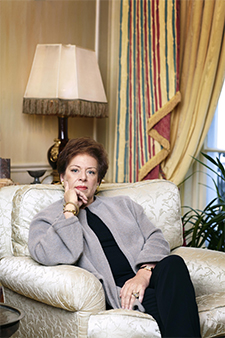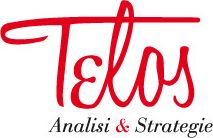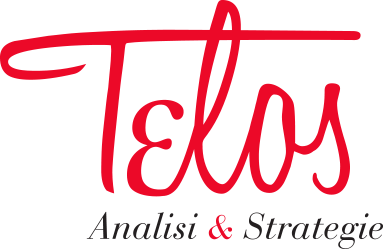May 2018, Year X, n. 5
Patricia Wengraf
The lady of the art market
“Most European countries have laws that control the export of art works that have been in the country for fifty years or more. But in Italy they have historically been more restrictive than in France and the UK. This has certainly hampered the trade in art works. Another factor leading many young Italian dealers to move abroad is the heavy bureaucracy and lack of foreign visiting clients.”
Telos: You are one of the world's leading dealers in bronzes, sculpture and works of art. What has been, in your view, the impact of the economic crisis on the art market worldwide?
Patricia Wengraf: I am not an economist so can only respond from a personal perspective as a dealer in Old Master art. Personally I have had some of my most successful years since 2007, due in part to the fact that an owner of some prime works, which I had been trying to buy for over twenty-five years, finally decided to sell, and a number of other works also came to me. Luckily, my collector clients have also felt confident focusing more on their collections, rather than stocks. I have also been approached by some new, younger collectors with whom I am now working. More broadly I am aware that a number of less experienced people who set up as dealers, or art advisors, (particularly in Contemporary Art), before or since 2007 have had to close, but that is normal in business. Similarly, though for different reasons, a number of Old Master dealers have recently chosen to retire, often when their leases expired. You ask about the impact of the economic crisis, yet the Dow Jones and FTSE are currently at all-time highs …in spite of Trump and Brexit. And in 2017 the auction houses reported a global increase in sales value of 25%.
An art collection always begins as a labour of love but, while the passion may remain, the collection typically also comes to be seen as a major financial investment—one that deserves serious tax planning. Is this an aspect that policy-makers should take into account when deciding to support the development of the market? And how?
The private collectors with whom I work are all highly professional people in their own sphere and normally have a fairly clear idea of how much they intend to put into their Art portfolio and have a tax plan in place or are at least aware of the various tax plans available to them. They might invest more than originally intended if some great works unexpectedly become available or if I propose an exhibition of their collection and writing an accompanying catalogue, thereby adding value. Until very recently the US government supported life-time Gifts of Art works in lieu of Tax to Museums. Historically this policy of life-time gifts has benefitted both US private collectors and museums alike, although it has yet to be seen if Trump’s change of policy affects the purchasing programs of American collectors. Whereas European Governments have never allowed life-time tax breaks in lieu of art works to individuals, France now offers this to companies (up to 10% of their annual net profits) if they gift a ‘desired’ major art work to a museum.
The main reason of the traditionally little relevance of the art market in Italy compared to the French, British or American markets seems to be the strictly protectionist approach of our art laws and regulations. Without any revolutionary changes, is there any reasonable intervention that you would suggest to our policy-makers that might have a positive impact on the currently stalling art market?
The strength of London’s art market lies in the expertise of its dealers, and in New York in the buying power of the American market. Both have historically perceived France and Italy as a source of old master art. Yet in both these countries there have always been serious collectors who have usually preferred to maintain a low profile and seldom chosen to spend as much on art, even if they had the financial means of some American collectors. Most European countries have laws that control the export of art works that have been in the country for fifty years or more. But in Italy they have historically been more restrictive than in France and the UK because they allow the authorities to Notify a work of art, thereby preventing the owner from exporting it, with no obligation by the nation to buy it. Consequently, a Notified work can only be sold in Italy at a greatly reduced price compared to its value on the international market. This has certainly hampered the trade in art works. Another factor leading many young Italian dealers to move abroad is the heavy bureaucracy and lack of foreign visiting clients. These two issues have contributed to Florence’s Via Maggio and Rome’s Via Babuino becoming practically devoid of art dealers. Some have moved to London and others to New York, where it is easier to work. Yet curiously the art market in Genoa is bouyant.
One last question on your amazing career as an art dealer and as a scholar. What do you regard as your most important purchases and discoveries?
In 1981 I was lucky enough to buy a great bronze, a lost work by the Florentine baroque sculptor Foggini, very cheaply because a colleague had literally fallen asleep in the auction room! But my first great discovery involved a long court case, against the French Customs, Ministry of Culture and Museums of France which I won. In 1987 I bought a life-size marble male figure at an auction in Angoulême described as 18th century, whereas I knew it to be a lost statue of Paris by Gabriël Grupello – “the northern Bernini”. The sculpture now adorns the Germanisches Nationalmuseum, Nürnberg, where it rightly belongs. My greatest discovery, for which I am best known, came when looking through a Christie’s catalogue in 1989. I came upon a half-length marble female figure described as ‘Venus Marina 18th century’, which I immediately recognized as a Giambologna even before checking Raffaello Borghini’s 1584 volume, in which his description of the Fata Morgana absolutely matched the image in the catalogue. The marble was recently exhibited in Florence in the Cinquecento exhibition at Palazzo Strozzi. On a much smaller scale, a bronze Pacing Horse simply described as Paduan 16th century fascinated me when it appeared at auction in Florence. Unlike most bronze experts, who know little of horses, I was virtually brought up on one - and still enjoy riding when possible. So in the Pacing Horse, I noticed that the sculptor had curiously depicted the horse ‘dishing’, a flaw of its gait. The horse’s tail was also tied-up in a unique manner. The model’s origin unfolded when I looked at drawings of horses by Leonardo da Vinci, some of which include these characteristics. It is currently on loan to the Metropolitan Museum of Art, New York, from the Quentin Foundation for which I also found, hidden beneath many layers of dirt, the finest cast known of Giambologna’s bronze statuette of Mars, and more recently a large terracotta modello for an unknown bronze roundel also by Giambologna. Since 2000, for another client I have created the finest collection of Giambologna bronzes, exhibited in Renaissance and Baroque Bronzes from The Hill Collection at The Frick Collection in 2014. It included the very exciting and striking Bacchic Man, a truly remarkable bronze widely held to be by Adriaen de Vries. In addition to finding such wonderful works, I also greatly enjoy working together with clients, who invariably become good friends, and forming their collections and developing their eye.
Marco Sonsini
Editorial
It took Silvio Berlusconi, torn between abstaining and not supporting a vote of confidence in the attempt to form a Five Star Movement–League government, to shine the spotlight on AMART, the Milan antiques fair, where he allegedly purchased a painting of a female nude by Chagall. As it turns out, there was no Chagall, and it was later discovered that this female nude was by Rome painter Giuseppe Carosi, displayed for the first time at the Venice Biennale in 1924.
However, if it hadn’t been for Berlusconi and the political contingency, would AMART have ended up in the newspapers? No way. Yet never before have art, the market, culture, the economy and finance crossed paths than in the last twenty years. Chinese artist Ai Weiwei said that everything is art, and everything is politics. We might also add that everything is economics. The value of art and money is dictated by social convention, by the value that is abstractly attributed to these two things. In the end, both represent symbolic value systems.
In Italy, since the 80s the art market has begun to more and more closely resemble the show business industry: massive art shows for voracious exhibition-goers who are in a hurry and pay little or no attention to the works themselves because all they’re really interested in is sharing their experience on social media. But when we begin to shift our gaze over to the world of collectors, we realise that today the key players are actually the art dealers and art advisors. The figure of the art dealer took shape in Great Britain after the Second World War and it entails to be specialised in a specific sector. Patricia Wengraf, interviewed this month by PRIMOPIANOSCALAc, is one of the world foremost art dealers.
Wengraf has been studying, buying and selling sculpture for decades after she was awestruck by an exhibition of Giambologna bronzes when she was a young girl. Wengraf talks to us about this passion and how she has bought and sold museum pieces now on display in the Met, the Louvre, the Getty, the Bode and the British Museum. Her mentor was the great art historian Sir John Pope-Hennessy, who nurtured her interest in bronzes, says Wengraf, and it was through Pope-Hennessy that she met Claudia Quentin, the daughter of an Argentine tycoon and great art collector, in 1982.
For the Quentin Foundation, Wengraf put together a collection of Renaissance bronzes and terracotta models that were later hosted by the Frick Collection in New York in 2004. Ten of the works in this collection were recently loaned to the Metropolitan Museum of Art in New York, where they are currently on view. Hence, Wengraf is both an art dealer and an art advisor, in that she also oversees the creation of actual collections, purchasing works directly for the collector, without having to dip into her own pockets.
However, this word has been taking on another meaning, perhaps because art and finance have never been as closely linked as they have in recent years, even in Italy: for banks and asset management companies, offering clients art advisory services has almost become a must, because there are increasingly more people who chose to diversify their portfolio and protect their assets using works of art. People do this for various reasons, which have to do with an unwillingness to take risks and with tax advantages, and no longer only with their passion for works of art.
For instance, Thierry Ehrmann, founder and president of Artprice, the world leader in art market information, says that ‘the art market has massively increased in liquidity’ and points out that now, like never before, this market ‘ensures that art may be bought and sold, in the right place, at the right time. At a time when bank interest rates are going down, art offers people an especially appealing and competitive investment alternative.’ Wengraf explains to us how here in Italy we have some obstacles that hinder the development of this market related to legislation that doesn’t foster growth.
One feature of the Italian tax system that has boosted this market, however, is that there is no capital gains tax on the sale of artwork. It goes without saying that we must have a regulatory framework that fosters the development of this industry. Governments need to direct their attention to countries like the USA, the United Kingdom and France, which traditionally have provided incentives for art patronage and collecting. In our work as lobbyists we have realised that in the 2018 Draft Budget Bill attempts were being made to regulate, or rather to get rid of the current tax regime on capital gains for individuals: the only thing even other countries envy us for. This attempt fell flat. Surely, this couldn’t have been the hand of lobbyists, could it?
Mariella Palazzolo

Patricia Wengraf is one of the world’s leading experts on bronzes, sculptures and works of art. A London-based art dealer since 1979, Patricia is renowned for sourcing the finest works available, most particularly in the highly specialised field of Renaissance and Baroque bronzes in which she is widely recognised as having an exceptional eye. Drawing on her in-depth knowledge and connoisseurship, she has published many essays and articles on old master sculpture. It was Anthony Radcliffe who first encouraged her to write a short article for The Burlington Magazine (published December 1988), about her discovery of a couple of bronzes that are similarly signed. Her exhibition catalogues for European Bronzes from The Quentin Collection in 2004 and Renaissance & Baroque Bronzes from The Hill Collection in2014 (both held at The Frick Collection, New York and both collections formed by Wengraf), set a new benchmark for such publications and for bronze scholarship. Professor Weil-Garris Brandt commented: “You have shown us all how to really look at bronzes”. Wengraf’s other interests include opera, cinema and cooking - particularly when at home in Tuscany, where the produce is so very fresh.
Marco Sonsini







SocialTelos